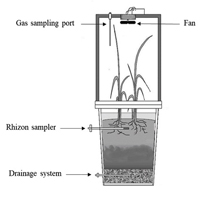Carbon input management in temperate rice paddies: Implications for methane emissions and crop response

Accepted: 27 April 2020
HTML: 109
All claims expressed in this article are solely those of the authors and do not necessarily represent those of their affiliated organizations, or those of the publisher, the editors and the reviewers. Any product that may be evaluated in this article or claim that may be made by its manufacturer is not guaranteed or endorsed by the publisher.
Agriculture contributes to over 20% of global anthropogenic greenhouse gas emissions and irrigated paddy fields account for 5- 10% of CH4 emissions. Main organic input providing methanogenesis substrate is straw. We hypothesized that removing rice straw can mitigate CH4 emissions, and that replacing its carbon (C) input with raw or solid digestate can be a valuable alternative both for crop, soil and emission responses. A mesocosm study was setup to follow crop growth, changes in soil pore water chemistry (dissolved Fe(II) and dissolved Organic C), and CH4 emissions over one cropping season on soil treated with the combination of two straw managements (removal or incorporation) and three fertilizations (mineral, raw digestate, solid digestate). Soils not receiving straw on average emitted 38 % less than soils after straw incorporation, while the two organic fertilizers did not increase emissions with respect to mineral N application. Furthermore, straw incorporation induced a yield depression independently from the fertilization strategy, probably as a result of N immobilization, especially in early stages. This was evidenced by early SPAD observations and flag leaf length, and both grain and straw final production. Moreover, the two organic fertilizers were not fully able to sustain crop N requirements with respect to the mineral fertilizer. Straw management was therefore decisive for determining both rice yield and CH4 emissions, while the impact of fertilization treatments was crucial only for crop productivity.
Highlights
- Rice straw incorporation into the soil increased methane emissions with respect to its removal
- No significant differences in methane emissions were observed between mineral and organic fertilization
- Both straw incorporation and organic fertilization decreased rice productivity
- Pore water Fe(II) concentrations represented a good proxy for CH4 emissions especially during the initial stages of the cropping cycle.
How to Cite
PAGEPress has chosen to apply the Creative Commons Attribution NonCommercial 4.0 International License (CC BY-NC 4.0) to all manuscripts to be published.

 https://doi.org/10.4081/ija.2020.1607
https://doi.org/10.4081/ija.2020.1607



